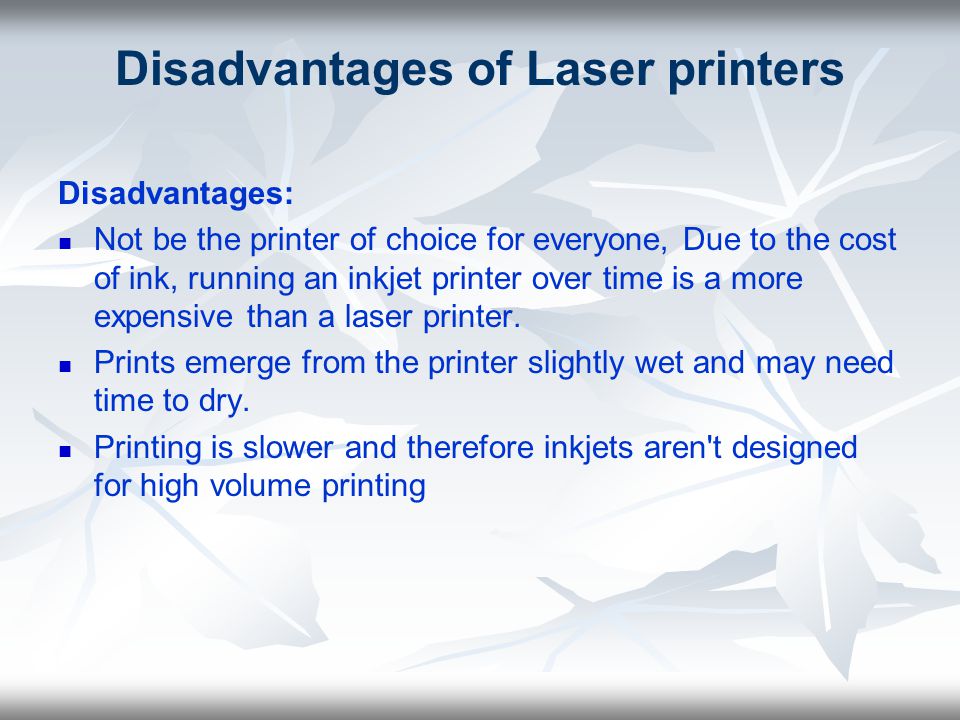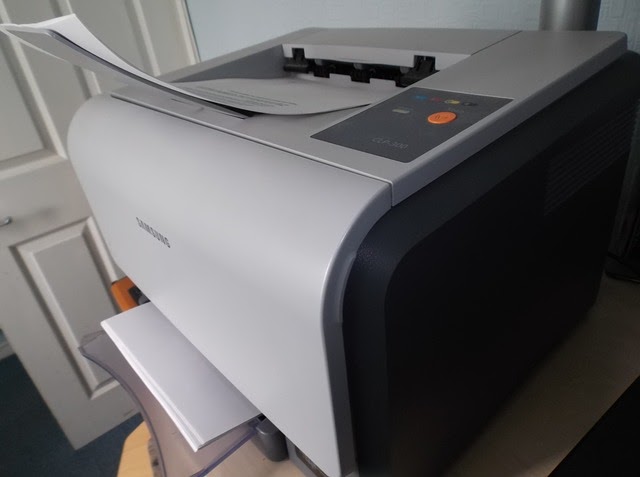Laser Printers: Unmasking Two Major Disadvantages You Should Know
Introduction
While advancements in technology have provided us with copious benefits, they also come with their share of drawbacks. In this article, we delve into the world of laser printers, deciphering not only their prime features but also two major disadvantages that every consumer should keep in mind.
What Are Laser Printers?
A laser printer is so much more than an office asset. It is an impressive technological invention that produces remarkable text and graphics. The way it operates can be broken down into several stages:
- A Laser Beam: The core component, the laser, zips across an electrostatically charged drum, creating an intricate binary pattern.
- Toner Application: Following the laser, the printer applies powdered ink, also known as toner, onto the pattern created by the laser. The toner is capable of adhering to the static charge.
- The Pressing Phase: Finally, this ink-dusted page is warmed and pressed, resulting in a crisp, non-smudged print.
Known for its precision and speed, a laser printer revolutionizes the entire printing process, pushing the boundaries of what's possible in high-quality commercial printing.
Peeling the Layers: What Makes Laser Printers Stand Out?
Laser printers have secured their spot in professional environments thanks to several outstanding qualities. Here's a look at the key benefits they offer:
- High-Speed Printing - When it comes to speed, laser printers comfortably outperform their counterparts. They can swiftly handle large-volume printing tasks, saving precious time in fast-paced settings.
- Exemplary Text Quality - Laser printers leave no room for compromise in quality. They notably distinguish themselves with exceptional text clarity, producing crisp and clear documents.
- High-Volume Capacity - Laser printers have a substantial print yield, making them an ideal choice for environments with bulk printing needs.
- Quiet Operation - Noise pollution is a considerable concern in the workplace. Fortunately, laser printers offer the benefit of quieter operations than other printers, contributing to a peaceful work environment.
- Less Maintenance - Over time, less maintenance can mean less disruption. The infrequent maintenance needs of laser printers allow for more productivity and less downtime.
- Versatility - The ability of laser printers to support various media sizes and weights adds to their versatility. They can handle a range of printing tasks, from standard paper printing to heavier cardstock.
In a nutshell, laser printers' fast speed, superior text quality, significant volume capacity, quiet operation, reduced maintenance, and wonderful versatility set them apart in the printing world. However, prospective buyers should not overlook their significant disadvantages before investing in them.

Disadvantage 1: Are Laser Printers really Cost-Prohibitive?
Laser printers’ initial investment presents as a considerable downside that often gets overshadowed by their superior attributes. For smaller-scale users or individuals, the weighty up-front expenditure may act as a fiscal deterrent.
Despite the long-term savings potential due to its ability to handle high volume printing and its lower cost per page, there are several hidden expenses associated with laser printers that must be considered:
- Initial Purchase Cost: Laser printers are notably more expensive than their counterparts, with prices for a standard machine ranging from around $200 to well over $1,000. This wide cost range is dependent on the printer's specifications and capabilities.
- Maintenance Expenditure: While laser printers are renowned for their robust and durable design, maintenance costs can pile up over time. For instance, replacement parts for a laser printer are considerably more expensive. Plus, professional servicing might be necessary for more serious maintenance issues.
- Toner Replacement: Toner, the 'ink' for laser printers, is significantly pricier than the ink used in other types of printers. A single toner cartridge can range anywhere from $50-$200, dependent on the model. Considering printers' thirst for ink, this expense is not to be ignored when evaluating overall printer costs.
- Hidden Costs: Additional costs such as power consumption and paper costs may not be as apparent when purchasing the printer but can add up to a significant amount over the printer's lifetime.
It’s important to note that although laser printers have high upfront costs, it’s their long-term running and maintenance costs that often catch consumers off guard. Therefore, a thorough cost-benefit analysis before purchasing could save unwary buyers from unexpected financial commitments in the long run.
Disadvantage 2: How Does Laser Printing Impact the Environment?
Laser printers, while efficient, unfortunately bear significant ecological consequences. Here's how:
- High Energy Consumption: Laser printers consume a substantive amount of electricity, especially during the warm-up and printing phases. The International Energy Agency reports that laser printers account for a staggering 10% of a typical office's electricity consumption.
- Waste Generation: Used laser printer toner cartridges could potentially add up to a significant amount of waste when discarded. Environmental Protection Agency data reveals that a single laser printer cartridge takes up to 450 years to decompose.
- Health Hazards: Some studies suggest that certain printer toners release micron-sized particles that could infiltrate our respiratory system, potentially causing harmful health impacts.
Despite these negative environmental impacts, specific steps can be taken to reduce these effects:
1. Toner Recycling: Be sure to recycle your used toner cartridges through established recycling programs. This act will help reduce waste and contribute to the production of refurbished cartridges.
2. Switch Off When Not in Use: Limit the energy consumption of laser printers by switching them off when not in use, especially over extended periods.
3. Choose Eco-Friendly Models: Some laser printers are designed with energy-saving features. Research thoroughly and opt for these eco-friendly models.
In conclusion, understanding the environmental impact of laser printers helps us become more responsible technology consumers. By making informed decisions and adopting sustainable practices, we can reduce the adverse environmental effects associated with these essential office tools.

Is There a Better Alternative to Laser Printers?
For individuals or businesses evaluating alternatives to laser printers, it’s crucial to consider the specific printing needs. There are numerous alternatives available, among which inkjet printers are a popular choice. They present significant advantages yet hold certain downsides as well.
Advantages of Inkjet Printers
- Lower Initial Cost: Inkjet printers are typically more affordable up front, making them more accessible for small businesses or personal use.
- Power Efficiency: Compared to laser technology, inkjet printers consume less electricity, thus having a smaller carbon footprint.
- Quality Color Prints: If vibrant color prints or high-detail photo printing is a requirement, inkjet printers often outperform laser printers in this area.
Disadvantages of Inkjet Printers
- Running Costs: While initial outlay might be lower, users may end up paying more in the long run. Ink cartridges need to be replaced more frequently than laser toner, which can contribute to higher ongoing costs.
- Printing Speed: Inkjet printers are generally slower, which might pose a downside for users with high-volume printing needs.
In conclusion, the choice of a printer type depends heavily on the intended usage and budget. Conducting a comprehensive analysis of all factors will ensure an informed and advantageous purchase decision.
Conclusion
Laser printers indeed offer distinct advantages, from speedy printing to superior text quality. However, potential buyers should also consider two significant drawbacks: environmental impact and high upfront costs. Thoroughly evaluating these factors can pave the way for an informed purchasing decision.
Related FAQs about what are two disadvantages of laser printers
Are laser printers worth the initial high cost?
The cost-effectiveness of laser printers depends on your usage. If you frequently print in large volumes or require high-quality prints, the investment might be worth it. However, the high initial cost and expensive maintenance might be a deterrent for infrequent or small-scale users.
Is there any way to lessen the environmental impact of laser printing?
Yes, there are few ways to lessen the environmental impact of laser printing. Recycling toner cartridges, switching off printers when not in use, and selecting energy-efficient models are some effective methods to minimize the ecological footprint caused by laser printers.
What are some recommended alternatives to laser printers?
Inkjet printers can be a viable alternative to laser printers. They are typically cheaper to purchase, consume less power, and provide excellent color prints, which makes them ideal for small businesses and personal use. However, they may have higher long-term costs.


